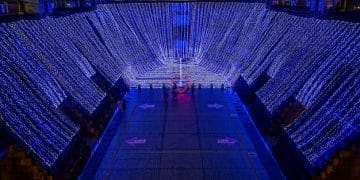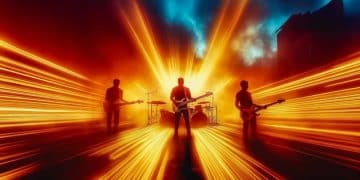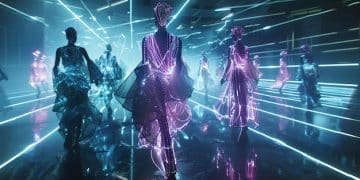The Evolution of Stage Designs: A 5-Year Visual Concert Analysis
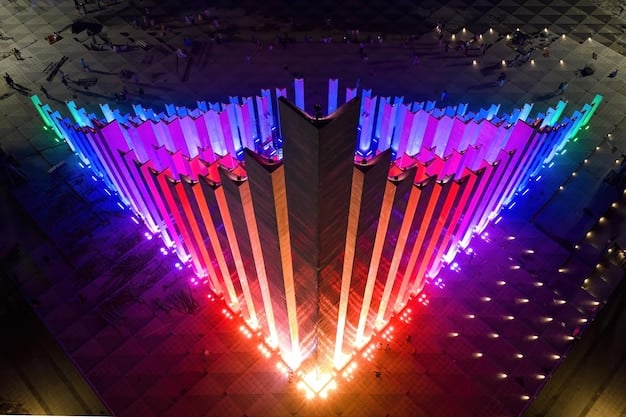
Over the past five years, stage designs in concerts have undergone a dramatic transformation, driven by technological advancements and creative innovation, prioritizing immersive visual storytelling and audience engagement.
The concert experience has always been a multisensory event, but in the last five years, the visual component has arguably become as crucial as the auditory. We’ve witnessed an astonishing evolution in how artists and production teams conceptualize and execute their live shows, pushing the boundaries of technology and creativity to deliver unforgettable experiences. This article delves into How Did Stage Designs Evolve in the Last 5 Years? A Visual Concert Coverage Analysis, examining the key innovations and trends that have reshaped the live music landscape and set new benchmarks for audience engagement.
The Rise of Dynamic LED and Video Walls
The omnipresence of dynamic LED displays and high-resolution video walls has fundamentally altered stage design. Gone are the days of static backdrops; today’s stages are fluid canvases that morph continuously, responding to every beat and lyrical nuance. This shift began subtly, but in the last five years, it has accelerated, making these technologies not just an addition but often the central element of a stage’s visual narrative.
This evolution brings a newfound versatility, allowing artists to transport their audience to different worlds within a single performance. From abstract digital art to realistic landscape simulations, the possibilities are virtually endless. The integration of cutting-edge pixel mapping and content synchronization ensures that every visual element aligns perfectly with the music, creating a cohesive and deeply immersive experience. These sophisticated systems require intricate planning and execution, often involving teams of specialized visual artists and technicians working in tandem with sound and lighting engineers.
Seamless Integration and Immersive Storytelling
The goal with modern LED and video wall integration is to create a seamless environment where the barrier between the stage and the audience blurs. This isn’t just about displaying pretty pictures; it’s about telling a story that complements the music, enhancing emotional impact and creating memorable moments.
- Artists leverage custom video content to punctuate narrative arcs within their sets.
- Interactive visuals react to live sound, audience movement, or even performer actions.
- High-resolution screens provide close-ups and unique perspectives, enhancing visibility for large crowds.
Technological Advancements Driving Creativity
The improvements in LED technology itself, such as higher pixel density, greater brightness for outdoor venues, and flexible panel designs, have fueled this creative boom. Designers are no longer limited by rigid, heavy screens. Instead, they can sculpt stages with curved, transparent, or even kinetic LED elements that move and transform throughout a show, adding another dimension of visual spectacle. This technological leap has empowered designers to implement visions previously thought impossible, directly contributing to the complex and breathtaking designs seen in contemporary concerts.
The rapid innovation in LED technology has made it more accessible and versatile. Prices have become more competitive, allowing more productions to incorporate sophisticated visual elements. This democratization of advanced tech has, in turn, spurred greater creativity, as designers now have a wider palette of tools to work with.
Kinetic Scenography: Stages That Move and Breathe
Beyond static or even responsive LED screens, the past five years have seen a significant increase in kinetic stage elements. These are components of the stage that move, transform, or reconfigure during a performance, adding a dynamic, almost living quality to the environment. This represents a paradigm shift from purely visual backdrops to physical structures that play an active role in the show’s choreography.
Kinetic scenography often involves sophisticated automated systems, including robotic arms, movable platforms, flying props, and transforming set pieces. These elements create moments of surprise and wonder, keeping the audience engaged and adding layers of complexity to the overall production. The careful timing and synchronization of these movements with music, lighting, and performer positioning are crucial for achieving the desired impact.
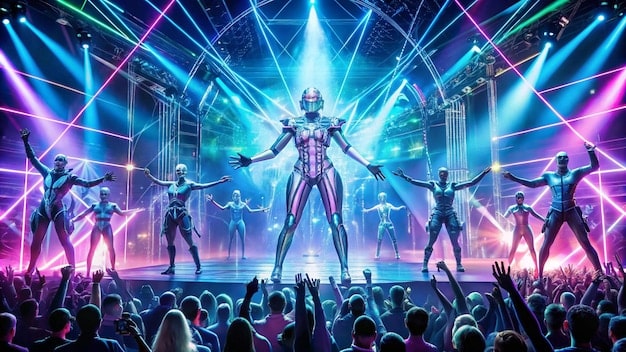
Robotics and Automation in Live Performances
The application of robotics in live stage design has moved beyond niche experimental acts to become a more mainstream feature in major tours. Robotic elements are not just for special effects; they can be integrated into the very structure of the stage, offering fluid transitions and endless configurations.
- Automated rigging systems allow for swift changes in stage elevation and component placement.
- Robotic arms manipulate lighting fixtures, screens, or even props with precision and grace.
- Transforming stage floors and walls create immersive environments that change with each song.
The Art of Transformation and Illusion
Kinetic designs are masterful at creating illusions and dramatic reveals. A stage might start as a simple platform only to unfold into a multi-tiered cityscape, or seemingly solid walls might part to reveal hidden performers or visual effects. This element of transformation keeps the audience perpetually guessing and creates memorable theatrical moments that elevate the concert experience beyond merely watching a band perform. The complexity of these systems demands highly skilled technical teams to operate, ensuring safety and flawless execution throughout the show.
The ability to transform a stage within seconds not only adds visual flair but also enhances the narrative flow of a concert. Artists can utilize these transformations to mark different “acts” within their show or to match the shifting moods and themes of their music. This fluidity injects a theatrical quality that keeps audiences captivated from start to finish.
Enhanced Lighting and Laser Spectacles
While lighting has always been integral to concerts, the past five years have seen an unprecedented surge in its sophistication and integration into broader stage designs. Advances in intelligent lighting fixtures, laser technology, and projection mapping have transformed stages into kaleidoscopic environments that dance in perfect synchronicity with the music and visuals. This shift moves beyond mere illumination, positioning lighting as an active participant in the performance’s aesthetic and emotional impact.
Modern lighting setups often involve hundreds of individual fixtures, each digitally controlled to produce intricate patterns, color changes, and movement. The precision now achievable allows for breathtaking displays that can highlight performers, create architectural illusions, or generate vibrant atmospheres that engulf the entire venue. Laser technologies have also become more refined, offering safer yet more impactful dazzling light shows that cut through fog and complement LED displays.
The Synergy of Light, Sound, and Space
The real magic happens when lighting is meticulously choreographed with both the music and other visual elements. It’s not uncommon for light cues to be pre-programmed to the millisecond, ensuring perfect harmony with every beat drop and chord change.
- Moving head fixtures create dynamic beams and patterns across the audience and stage.
- Pixel-mapping technology controls individual LEDs within fixtures, enabling complex animations.
- Lasers create architectural structures of light, adding depth and a futuristic edge.
Projection Mapping Goes Mainstream
Projection mapping, once a niche technology, has become a more commonplace tool in comprehensive stage design. It allows for the projection of video content onto irregular surfaces, turning architectural features, stage props, or even the performers themselves into screens. This technique can create incredible illusions, making solid objects appear to move, crumble, or transform into something entirely different. The ability to integrate these projections seamlessly with physical sets and LED screens adds another layer of depth and visual interest, blurring the lines between the tangible and the illusory. This creates a truly immersive environment that surrounds and engages the audience.
The accessibility and power of projection mapping software and hardware have increased significantly, allowing more designers to experiment with this dynamic medium. This technology transforms passive surfaces into active narrative elements, offering unparalleled flexibility in creating bespoke visual experiences for each performance.
Augmented Reality and Immersive Technologies
The most cutting-edge evolution in stage design over the last five years involves the integration of augmented reality (AR) and other immersive technologies. While not yet universally adopted due to technical complexities and cost, AR offers a glimpse into the future of live performance, allowing for virtual elements to be superimposed onto the real-world stage, visible through audience members’ phones or specialized screens. This technology merges the physical and digital, creating hybrid experiences that redefine what’s possible in a live concert.
Unlike virtual reality (VR), which transports users to an entirely digital world, AR enhances the real world with digital overlays. In concert settings, this might mean seeing virtual characters dancing on stage alongside performers, digital effects extending beyond the physical set, or interactive elements that respond to audience input via their devices. These experimental applications hint at a future where every concert could be a unique, personalized multimedia event.
Hybrid Worlds: Blending the Real and the Virtual
AR experiences in concerts are still largely in their infancy, often manifesting as specific moments rather than an entire show. However, artists are increasingly exploring its potential to add unique, unexpected layers to their performances. The challenge lies in scaling these experiences to large audiences and ensuring seamless integration.
- AR overlays on screen projections make virtual elements appear on the physical stage.
- Audience members interact with AR experiences through dedicated apps on their smartphones.
- Performers may interact with virtual characters or objects visible only through AR.
The Future of Audience Interaction and Engagement
The true power of AR in concert design lies in its potential for audience participation. Imagine holding up your phone and seeing a personalized visual effect radiating from your seat, or contributing to a collective AR display generated by thousands of audience members. This level of interaction moves beyond passive spectating, transforming the audience into co-creators of the visual experience. As these technologies mature and become more accessible, we can expect to see AR play a more prominent role, offering new avenues for deep, personalized engagement that was unimaginable just a few years ago. This promises a truly individualized and unforgettable concert experience for each attendee.
These interactive elements bridge the gap between performer and fan, creating a shared, dynamic universe where everyone contributes. The implications for fan loyalty and memorable experiences are profound, suggesting a future where concerts are less about consumption and more about collective creation.
Sustainability and Eco-Conscious Stage Production
Amidst the technological boom, another significant evolution in stage design over the past five years has been a growing emphasis on sustainability. As environmental awareness increases globally, concert productions are actively seeking ways to reduce their ecological footprint. This isn’t just a trend; it’s a critical shift towards responsible tour practices, influencing everything from material choices to energy consumption.
The pressure to adopt greener practices comes from various stakeholders: artists committed to environmental causes, environmentally conscious fans, and regulatory bodies. Consequently, designers are increasingly opting for reusable, recycled, or locally sourced materials for sets, and prioritizing energy-efficient technologies for lighting and sound. This commitment often involves a complete re-evaluation of the production process, from initial design concepts through to the tear-down and disposal of stage elements.
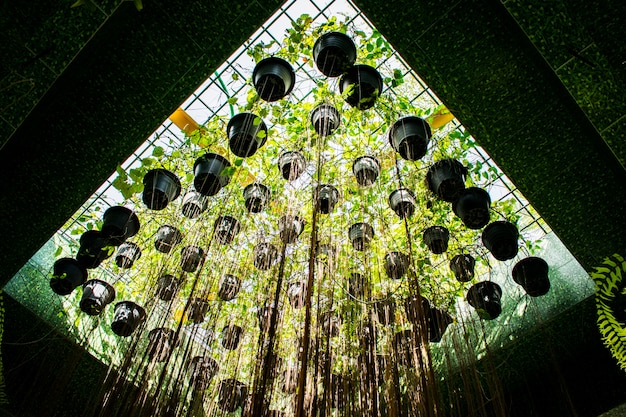
Minimizing Waste and Maximizing Reusability
The traditional model of touring production often involved creating elaborate sets that were then disassembled and sometimes discarded after a tour. The new focus is on circularity: designing elements that can be easily repurposed, recycled, or even flat-packed for efficient transport and multiple uses across various shows or tours.
- Use of modular stage components that can be reconfigured for different venues.
- Prioritizing lightweight, durable materials that reduce transport emissions.
- Incorporating recycled and upcycled materials into set elements.
Energy Efficiency and Renewable Power Solutions
Energy consumption is a major concern for large-scale concert productions. The transition to LED lighting, while offering aesthetic benefits, also dramatically reduces power use compared to traditional incandescent fixtures. Beyond lighting, productions are exploring renewable energy sources to power their stages, from on-site solar panels to biofuel generators. This not only lowers their carbon footprint but also can contribute to operational cost savings in the long run.
The shift towards more sustainable practices is not solely about environmental impact; it also reflects a broader cultural consciousness within the music industry. Artists and their teams are increasingly recognizing their platform’s power to advocate for change and demonstrate responsible practices, inspiring both their peers and their audiences to consider their own environmental impact.
Audience Experience and Accessibility Innovations
The evolution of stage design in the past five years has not solely been about visual spectacle; it has also increasingly focused on enhancing the overall audience experience and ensuring greater accessibility. Beyond the dazzling lights and intricate video walls, designers are now considering how the entire concert environment can be optimized for comfort, engagement, and inclusivity for every attendee. This represents a more holistic approach to live event production, recognizing that a truly great show encompasses more than just what happens on stage.
This involves innovations in how audiences perceive and interact with the show, incorporating technologies and design principles that cater to diverse needs. From improved sightlines and sound distribution to interactive elements that break down traditional barriers, the goal is to create a more personal and deeply connected experience for everyone in attendance.
Personalized Views and Enhanced Soundscapes
Technological advancements are allowing for more tailored experiences, even within a massive crowd. This ranges from strategically placed screens providing alternative views to immersive audio systems that deliver consistent sound quality across large venues.
- Distributed audio systems ensure optimal sound clarity regardless of seating location.
- Strategically placed repeater screens provide unobscured views for those further back.
- Integration of haptic feedback systems for audiences with hearing impairments.
Designing for Inclusivity and Comfort
Accessibility has become a more prominent consideration in modern stage and venue design. This includes not just physical accessibility for mobility-impaired attendees but also sensory considerations for those who might be overwhelmed by intense visual or auditory stimuli. Designers are exploring “chill-out” zones, visual guides, and other features to make concerts enjoyable for a wider demographic.
The drive towards greater inclusivity extends to psychological comfort as well. Creating spaces that feel safe, welcoming, and easy to navigate contributes significantly to an attendee’s overall enjoyment. This thoughtful approach to design ensures that the magic of live music can be shared and appreciated by as many people as possible, fostering a more diverse and engaged concert community. Ultimately, this focus on the human element ensures that technological prowess serves a greater purpose: enhancing shared, memorable experiences.
| Key Trend | Brief Description |
|---|---|
| 💡 Dynamic LED & Video Walls | Stages now feature fluid, high-resolution screens for immersive, changing narratives. |
| ⚙️ Kinetic Scenography | Stages incorporate movable elements, robotics, and transforming structures for dynamic shows. |
| 🌈 Advanced Lighting & Lasers | Sophisticated lighting and laser systems create immersive and choreographed visual effects. |
| 🌱 Sustainability Focus | Growing emphasis on eco-friendly materials, reusability, and energy-efficient production. |
Frequently Asked Questions About Modern Stage Design
The most significant advancements include dynamic LED and high-resolution video walls, sophisticated kinetic scenography with robotics, enhanced intelligent lighting and laser systems, and emerging applications of augmented reality. These innovations allow for more immersive, interactive, and visually stunning concert experiences that were unimaginable a decade ago.
Sustainability has become a core consideration. Designers are increasingly using recycled or reusable materials, prioritizing modular designs for reduced waste, and opting for energy-efficient technologies like LED lighting. This reflects a growing eco-consciousness within the music industry, aiming to minimize environmental footprints across entire tours.
Video walls now often serve as the central visual element, transforming stages into dynamic, fluid canvases. They display custom content synchronized with music, creating immersive narratives and transporting audiences to various digital worlds. High-resolution, flexible LED panels allow for complex shapes and seamless integration, enhancing storytelling and audience engagement.
While still in its experimental stages, augmented reality (AR) is increasingly explored in concerts. It superimposes virtual elements onto the physical stage, visible through screens or devices, blending real and digital worlds. Though not yet universally common due to technical challenges, AR promises future personalized and interactive experiences for concert-goers.
Beyond visual spectacle, modern stage design focuses on holistic audience experience and accessibility. This includes optimizing sightlines, distributing sound evenly, and integrating interactive elements. Designers are also considering inclusivity through features like sensory-friendly zones and accessible physical layouts, aiming to create a comfortable and engaging atmosphere for all attendees.
The Enduring Impact of Visual Innovation in Live Music
The transformation of stage designs over the past five years is more than just a fleeting trend; it represents a fundamental shift in how live music is experienced and produced. From the ubiquitous, dynamic LED displays and intricate kinetic structures to the increasing integration of augmented reality and a critical push towards sustainability, every aspect of concert visuals has evolved. These innovations are not merely about spectacle; they are about crafting more immersive narratives, fostering deeper audience connections, and pushing the boundaries of artistic expression within the live performance realm. As technology continues its relentless march forward, we can anticipate even more groundbreaking developments, ensuring that the concert stage remains a vibrant canvas for human creativity and engineering prowess, continuing to captivate and inspire audiences worldwide.
